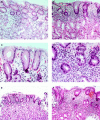Helicobacter pylori gastritis and epithelial cell proliferation in patients with reflux oesophagitis after treatment with lansoprazole
- PMID: 9462205
- PMCID: PMC1891604
- DOI: 10.1136/gut.41.6.740
Helicobacter pylori gastritis and epithelial cell proliferation in patients with reflux oesophagitis after treatment with lansoprazole
Abstract
Background: Helicobacter pylori gastritis may spread proximally in the stomach during profound acid inhibition.
Aims: To examine histological gastric body changes and epithelial cell proliferation before and after treatment with lansoprazole.
Patients and methods: Patients diagnosed as having reflux oesophagitis grade 1 or 2 were enrolled and treated for 12 weeks with lansoprazole (30 mg every morning). After 12 weeks, 103 of the 118 patients appeared endoscopically healed and were asymptomatic; they then received maintenance treatment with 15 or 30 mg lansoprazole daily. Biopsy specimens obtained from similar sites before and after treatment, were available from 90 patients after a median of 64 weeks (range 15-73 weeks). Epithelial cell proliferation was determined by the number of Ki-67 antigen positive cells per gland.
Results: Of these 90 patients, 44 (49%) were found to be infected with H pylori. Their median inflammation score had increased from grade 1 before to grade 2 after treatment (p < 0.0001). Initially, the number of Ki-67 antigen positive cells per gland was significantly higher in the H pylori infected than in the uninfected group and increased further after treatment (p < 0.0001). In uninfected patients, no significant change in inflammation or proliferation occurred during treatment.
Conclusions: A marked increase in body gastritis was observed in H pylori infected individuals during long term treatment with the proton pump inhibitor lansoprazole. Epithelial cell proliferation and atrophy also increased in infected but not in uninfected patients.
Figures





References
Publication types
MeSH terms
Substances
LinkOut - more resources
Full Text Sources
Medical
